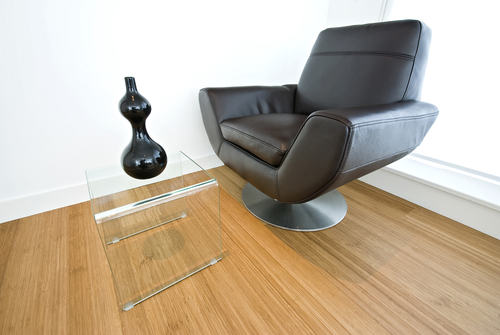Bamboo Flooring is a very popular flooring option among homeowners today. It’s modern look and high durability makes it an excellent choice for just about any area of your home. Bamboo flooring will add beauty and style and can help increase the value of your home as well. In order to help determine whether or not bamboo flooring is a good choice for you, there are some things you should know. In this article we’ll talk about 5 things you should know about bamboo flooring.
1.) Bamboo flooring does not have a wide variety of styles and colors to choose from. Bamboo typically comes in three styles. Horizontal where the bamboo is manufactured laying flat; Vertical where the bamboo is manufactured laying on its edge and strand bamboo where ground up bamboo is adhered together. Each of these styles gives you a slightly different visual. Bamboo typically is available in 2 colors. Natural, which is a blonde color, or carbonized, which is a process during manufacturing that gives it a dark caramel color. Because bamboo is extremely hard and dense, it does not generally take a stain well. This is why you will usually only see a couple of colors available to choose from.
2.) Bamboo flooring is an eco-friendly “green” product. Because of the rapid rate at which bamboo grows, it is more of a renewable resource than traditional hardwood floors that are manufactured from trees that are at least 20 years old. Eco-friendly products are very important to homeowners today, which is why bamboo floor is gaining so much popularity.
3.) The hardness of bamboo flooring makes it a very durable flooring option. The hardness level of bamboo according to the Janka Hardness Test is 1762, which is substantially higher than traditional red oak or maple floors. Strand bamboo tests much higher at 3014, making it one of the hardest flooring products available today. This hardness helps resist denting and will help your flooring look better longer, even in heavy traffic areas of your home.
4.) Bamboo flooring is very easy to maintain. The preferred method of cleaning is through sweeping and vacuuming. Every once in awhile, for a deeper clean, you can spray a light mist of cleaner from a spray bottle and wipe up with a clean towel or swiffer dry mop. It’s important to avoid getting too much water on your bamboo floor as this could lead to moisture damage. If your floor gets excessively worn, refinishing bamboo is an option. This is where your existing floor is sanded and a new coat of finish is put over the bamboo making it look new again. This greatly adds to the life span of your bamboo floor.
5.) Bamboo floors come in both solid and engineered forms. This allows you to use many different types of installation methods such as nail down, floating, or glue down. This also allows you to install your floor in areas that you wouldn’t be able to install a traditional solid hardwood floor in, such as basements and/or over concrete sub floors.
As you can see, bamboo flooring has many different benefits from it’s durability and eco-friendly properties. Really, one of the only downsides to bamboo flooring is it’s lack of styles and colors to choose from. However, bamboo comes in very neutral colors so many times this doesn’t pose a problem to the average homeowner. Bamboo flooring is an excellent flooring option and will add beauty, style and warmth to any home.



